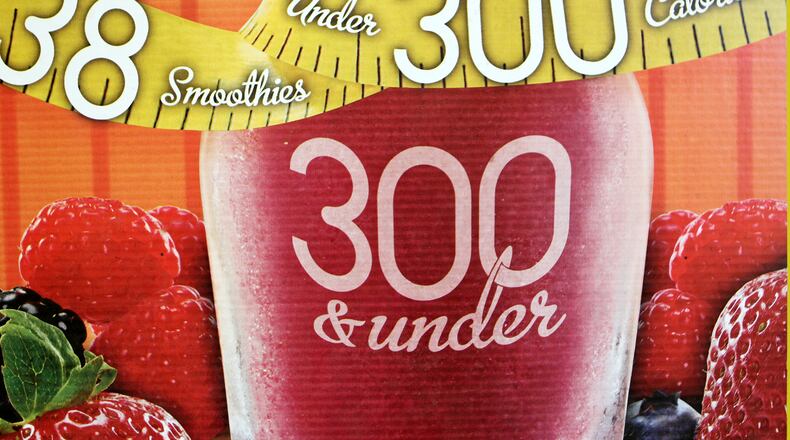On the warmest of days, nothing beats the summer heat like an icy beverage. The good news is frozen drinks are everywhere -- from Starbucks to McDonald's to the nearest gas station. QuikTrip offers more than 10 frozen drink choices, and some of the newer stores promise as many as 20 frozen drink options.
But alas, some of these cool treats can pack a lot of calories (some topping more than 600 calories) and put a chill on your efforts to slim down. So how does ice, just frozen water, get so fattening? Jennifer Teems Seay, an in-patient clinical dietitian at Piedmont Hospital said it's all that creaminess, added sugar and syrups and enormous drink sizes add up to a lot of "hidden" calories.
Still, experts say it's OK to indulge in the occasional frozen treat, and it's possible to revel in them on a more regular basis, especially if you do it yourself.
Here are some tips from Seay and Marisa Moore, a local dietitian and spokesperson for the Academy of Nutrition and Dietetics, on enjoying frozen drinks — and avoiding calorie landmines.
Starbucks
A 16-ounce caramel frappuccino has 410 calories, 15 grams of fat and 64 grams of sugar.
Slim it down a little: Go for a light caramel frappuccino lightly blended of the same size for 140 calories, no fat and 29 grams of sugar.
Slim it down a lot: Go with an iced coffee for zero calories. (Add a pump of syrup for about 20 calories.)
Seay says: "I do think it's good that Starbucks has the light option, and [that] is not that much, especially if that's your only indulgence during the day. These drinks are usually nonfat, so just recognize that most of the calories are probably from sugar... I have absolutely no problem at all with iced coffee. There is constantly a debate going on about coffee in the nutrition world. Does it have health benefits? Does it cause harm to your health? A lot of people disagree on this, but we do know it doesn't have any calories if it's black."
Moore adds: "Another option: order an iced herbal or vanilla tea. Ask for it plain or at half the usual sweetness."
Smoothie chains
Made with real fruit, smoothies can have some redeeming value, but serving size is important. Those bigger sizes, more to enjoy, but also a lot more calories.
Smoothie King, for example, offers their smoothies in three sizes: 20 ounce, 32 ounce and 40 ounce. A 20-ounce "Angel Food" smoothie with strawberries, bananas, soy protein and turbinado sugar contains 354 calories. Omit the sugar and make it a "skinny" smoothie of the same size for 254 calories. But if you fill up on a 40-ounce "Angel Food," smoothie, that fruit smoothie will pack a whopping 708 calories.
Moore says: "Smoothies wear a health halo leading many to believe they are harmless. However, a 20-ounce fruit smoothie can run as much as 500 calories. You have to be a bit of a detective to outsmart frozen drinks. Look out for these code words — whipped cream, creamy, drizzled (with anything) and decadent — and opt out the whipped cream to save calories."
DIY Smoothies
Seay and Moore often make their own smoothies at home. Seay's recipe calls for one cup of frozen strawberries, one-half cup of frozen blueberries, one-half cup of frozen raspberries, one banana, one cup of orange juice and either one-and-a-half cup of nonfat milk or one-and-a-half cup of soy milk (the fruit should be covered up with liquid in the blender and then blended) Note: If you use frozen fruit instead of fresh you don't have to add ice to make the smoothie frozen.
This vitamin-rich recipe makes four, 8-ounce servings with 107 calories, zero grams of fat if made with milk; 1 gram of fat if made with soy milk.
Pay attention to serving size. A "Blueberry Heaven" smoothie in a 20-ounce cup has 340 calories. The same smoothie in a 40-ounce size packs 680 calories.
Read the ingredients. Avoid added sugar, and other code words to avoid: whipped cream, creamy and drizzled.
Don't make it a daily habit. If you are going for a full-calorie splurge, make it an occasional indulgence of no more than once a week.
Make it yourself to better control what you are consuming. Turn your smoothie craving into a healthy way to eat by making smoothies at home with seasonal fruit and ice. Consider adding nonfat yogurt, and if you are feeling adventurous, add spinach or kale to the blender to pump up the nutrients.
Beware of mixed adult beverages. An average margarita has just under 400 calories, coladas even more. Try a lower-calorie beverage by combining equal parts wine and club soda for just 80 calories and half the alcohol of a glass of wine.
SOURCE: Marisa Moore, spokesperson for the Academy of Nutrition and Dietetics.
About the Author
Keep Reading
The Latest
Featured


